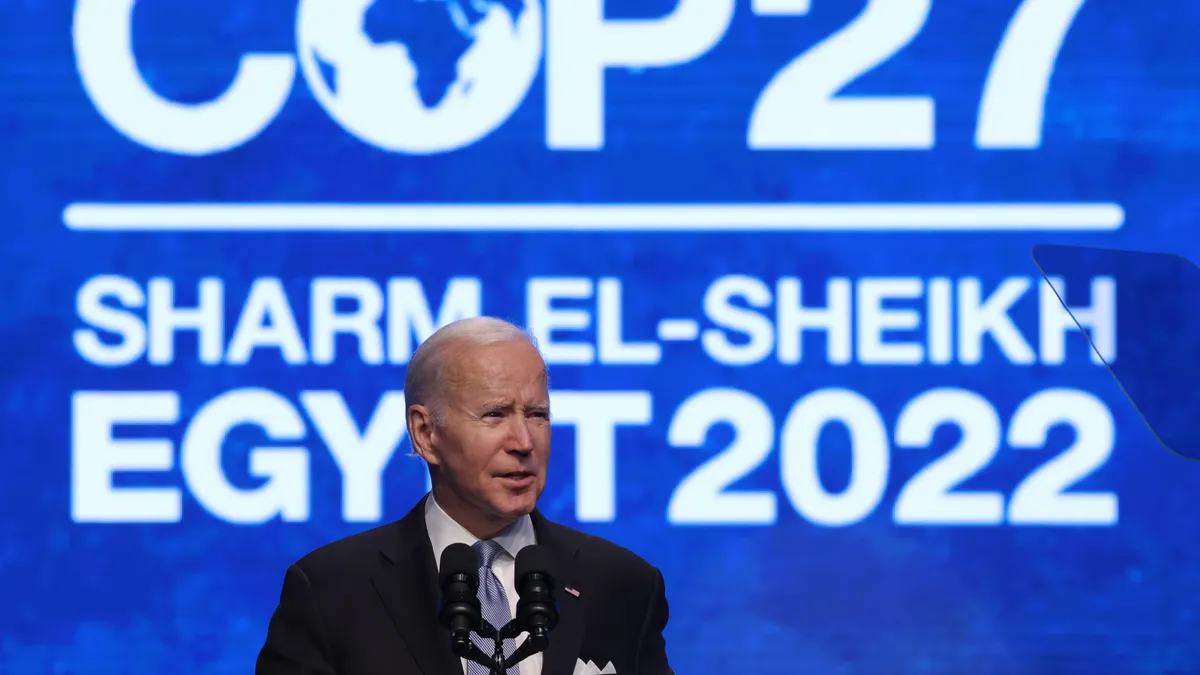Dive Brief:
- The Biden administration announced the first-ever federal building performance standard on Wednesday, a policy move intended to help achieve net-zero emissions in all federal buildings by 2045.
- The new standard sets a goal of cutting energy use and electrifying equipment and appliances in 30% of building space owned by the federal government by 2030. Also on Wednesday, the U.S. Department of Energy announced proposed rules to electrify all new federal buildings and federal buildings undergoing major renovations, the White House stated.
- In related news, the White House announced Wednesday that the state of California will join the Biden administration’s National Building Performance Coalition, continuing the momentum of state and local governments committed to cutting emissions in existing buildings.
Dive Insight:
States and cities throughout the U.S. have turned their attention to reducing carbon emissions in buildings to try to reduce the impacts of the climate crisis. Residential and commercial buildings generate 35% of U.S. carbon dioxide emissions, according to the White House.
The Biden administration has been active in addressing this issue, both in terms of decarbonizing federal buildings and encouraging states and cities to take action. Last year, it signed an executive order directing the federal government to use its powers to achieve net-zero emissions throughout its entire building portfolio by 2045, including a 50% emissions reduction by 2032.
To reach the new standard set on Wednesday, agencies will purchase heat pumps, electric water heaters and other energy-efficiency and building-system technologies that are built in the U.S. and supported by the Inflation Reduction Act that passed in August, the White House stated.
Funding for those efforts will be provided through the bipartisan infrastructure law that passed last year, agency operating budgets and the Climate Smart Buildings Initiative, the White House stated.
The move has received pushback from the American Gas Association, which called the rule “impractical, unscientific and expensive” with “no environmental benefit.”
“In reality, the demand for electricity fueled by natural gas will only increase and the costs [of electrification] will be borne by every taxpayer,” the AGA stated. The group, which represents gas distribution companies, said it “supports the goal of lower emissions and is investing every day to continue to decarbonize our systems. AGA will thoroughly evaluate the proposal and vigorously participate in the public comment process.”
The move was hailed by a number of organizations that push for building decarbonization policies. Steven Nadel, executive director of the American Council for an Energy-Efficiency Economy, said in a statement that the announcement is significant because the federal government is the largest real estate owner in the country.
“It’s a plan that could reduce the government’s capital costs and make a big cut to its greenhouse gas emissions,” said Nadel. “This should serve as a model for states, cities, and building owners around the country who are increasingly looking to decarbonize and cut costs.”
Johanna Neumann, senior director of Environment America’s Campaign for 100% Renewable Energy, said in a statement that the new rule could entice other communities to follow the federal government’s lead.
“Today’s commitment will reduce energy costs and spur a nationwide switch to buildings that waste less and pollute less,” Neumann said. “When courthouses in Iowa and federal buildings in Florida stop heating and cooling with fossil fuels such as gas, coal or propane, it paves the way for others in their community to follow.”
In January, the administration launched the Building Performance Standards Coalition, a partnership among more than 30 city and county governments, along with the states of Colorado and Washington, with the goal of advancing legislation or regulation to achieve cleaner, healthier and more affordable buildings in each jurisdiction by April 22, 2024. Several additional governments have since joined the coalition, now including California.
According to the White House, between the federal building performance standards and the addition of California to the coalition, one-quarter of all commercial, federal and multifamily buildings in the U.S. are either covered by or moving toward sustainable building performance standards.












